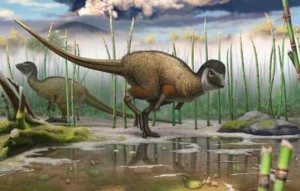Fossil Discovery in Siberia Challenges Palaeontologists
Scientists have announced the discovery of a new species of dinosaur in Siberia, a one-metre long Jurassic dinosaur that had feathers as well as scales. The dinosaur has been named Kulindadromeus (K. zabaikalicus), the genus name is pronounced, Cul-lin-dah-dro-me us, the species or trivial name is pronounced zah-bay-cal-lik-us. This little dinosaur, most probably a biped, has been named after the Kulinda valley in Siberia and the Greek word “dromeus”, which means runner. The trivial (species) name honours the Zabaikal krai region of Siberia in which the Kulinda valley is located.
Kulindadromeus Dinosaur
An Illustration of the New Feathered Dinosaur
Picture credit: Andrey Atuchin
Feathered Dinosaurs
Feathered dinosaurs have been discovered before, but until now most of the feathered dinosaur discoveries related to a specific group of saurischian dinosaurs, (lizard-hipped), known as the theropods. Kulindadromeus is relatively basal to a group of bird-hipped dinosaurs known as the ornithischians. This discovery suggests that feathers in dinosaurs evolved relatively early in their history and that many different members of the Dinosauria were probably covered in feathers.
To read more about this fossil discovery: Did all the Dinosaurs have Feathers?
Extension Ideas and Activities
Key Stage 2
- Look up articles on feathered dinosaurs, from which parts of the world have these fossil discoveries come from?
- What evidence have scientists found in fossils to suggest that some dinosaurs were feathered?
- What reasons can the class come up with for the evolution of feathers in dinosaurs?
Key Stage 3/4
- Just two years after Darwin’s “Origin of Species” was published a virtually complete fossil of the “First Bird” Archaeopteryx was found in Germany. How did this fossil discovery support Darwin’s theory of natural selection?
- Look up pictures of Archaeopteryx and fossils of this Late Jurassic creature, what similarities to modern birds can be seen, what are the differences?
- Why might this fossil be described as “transitional”?
- Why are there few examples of transitional fossils preserved in the fossil record? Can the theory of natural selection explain this?
For models of feathered dinosaurs, mostly theropod dinosaurs take a look at the huge selection of models and figures available at Everything Dinosaur: Everything Dinosaur Models and Figures.


